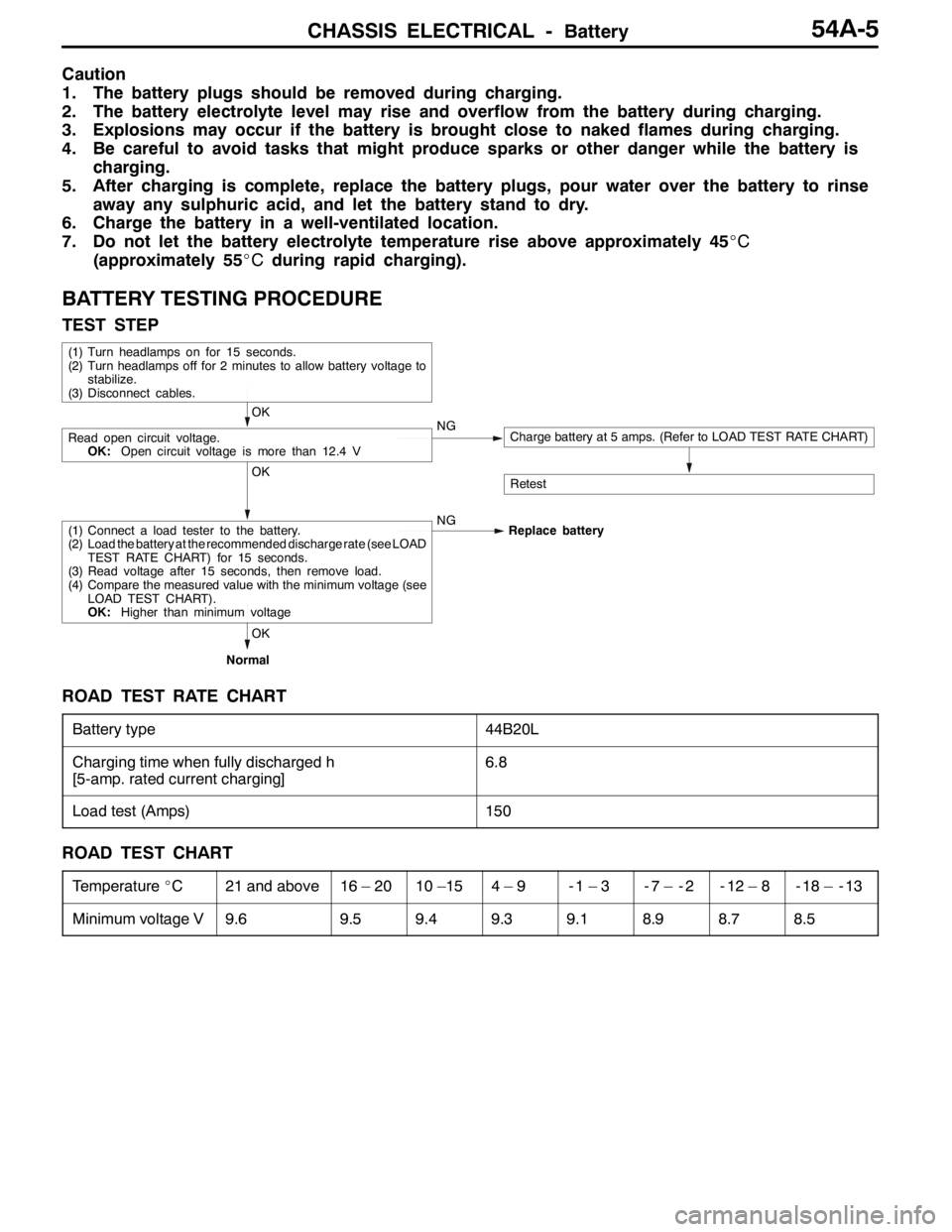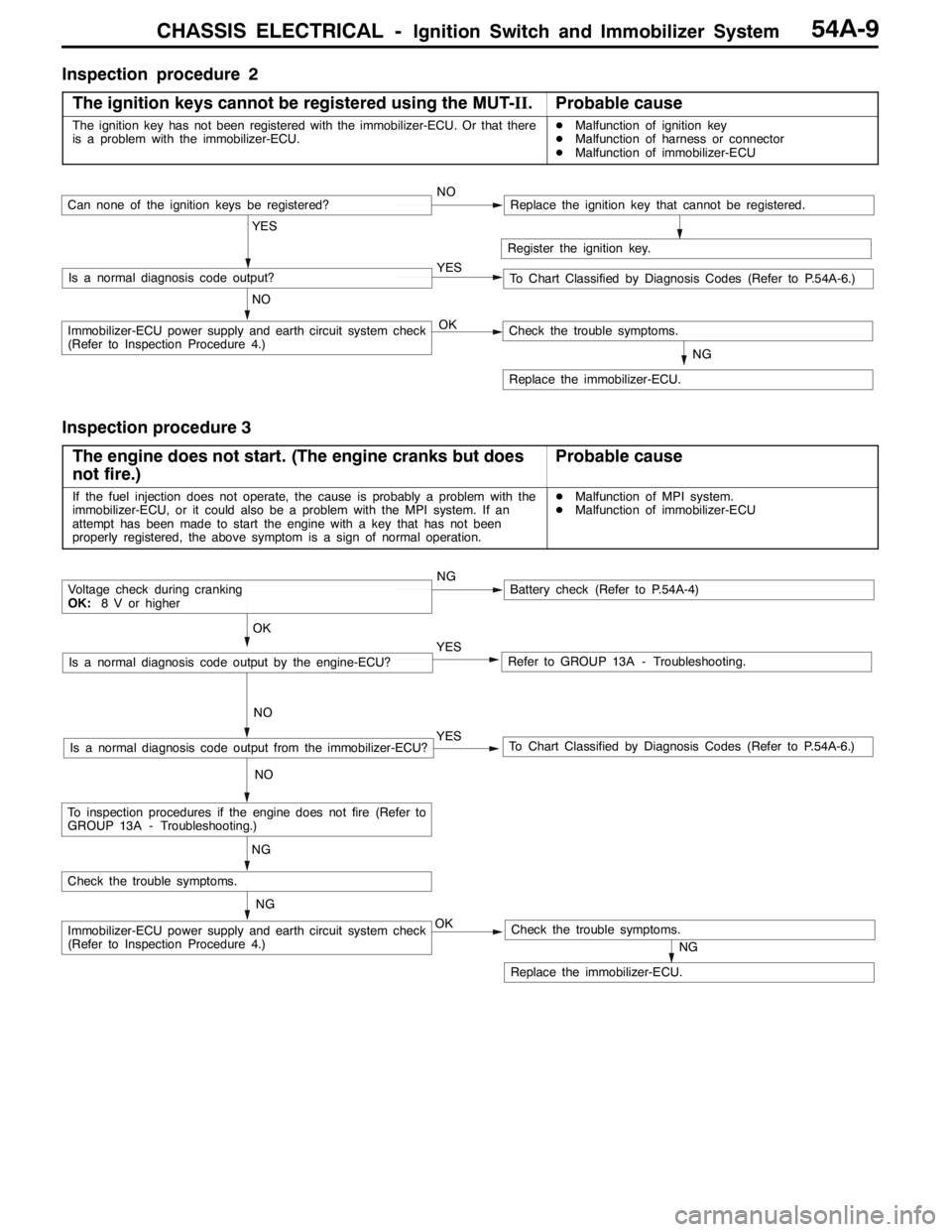2007 MITSUBISHI LANCER EVOLUTION battery
[x] Cancel search: batteryPage 1314 of 1449

SRS -AirBagModuleandSeatBeltPre-tensioner
Disposal Procedures52B-70
(7) Separate the deployment harnesses as far from the
driver’s side air bag module as possible and connect
to the terminals of the battery removed from the
vehicle. Then deploy.
Caution
1) Before the deployment, see that no one is near
around the driver’s air bag module.
2) The deployment makes the inflator of the
driver’s air bag very hot. Before handling the
inflator, wait more than 30 minutes for cooling.
3) If the driver’s air bag module fails to deploy
although the procedure is respected, do not go
near the module. Contact your local
distributor.
(8) Discard the deployed air bag module as specified
in Deployed Air Bag Module Disposal Procedures.
(Refer to P.52B-75.)
Driver’s side air bag module
(1) Remove the steering wheel - air bag module assembly
from the vehicle. (Refer to P.52B-52.)
Caution
Once disconnected, both electrodes of the driver’s
air bag module connector short automatically to
prevent accidental deployment caused by static
etc. Still, in consideration of the accidental
deployment, store the air bag module on flat place
with deployment surface facing up. Also, do not
put anything on it.
(2) Prepare two deployment harnesses longer than 6 m
for deployment and connect the terminals in one end
to short-circuit. This is to prevent accidental
deployment caused by static etc.
(3) Touch the vehicle’s body with bare hands to discharge
static in you.
Caution
Never fail to do Step (3) in order to prevent
accidental deployment caused by static.
Deployment harnesses
Shorted Deployment harnesses
6 m or longer
Page 1315 of 1449

SRS -AirBagModuleandSeatBeltPre-tensioner
Disposal Procedures52B-71
(4) Release the secured connector of the steering
wheel - driver’s air bag module assembly to cut off
the connector from the harness with a nipper and
etc. Connect deployment harnesses to each of two
separated harnesses and cover the area with
insulation tape.
(5) Use a rope to tie the steering wheel - driver’s air bag
module assembly to secure old tyres with wheels.
(6) Route the deployment harness connected to driver’s
air bag module beneath old tyres with wheels. Then,
secure the steering wheel - driver’s air bag module
assembly with the deployment surface facing up.
(7) Place three old tyres without wheels on the tyre
secured with the driver’s air bag module.
(8) Separate the deployment harnesses as far from the
driver’s side air bag module as possible and connect
to the terminals of the battery removed from the
vehicle. Then deploy.
Caution
1) Before the deployment, see that no one is near
around the driver’s air bag module.
2) The deployment makes the inflator of the
driver’s air bag very hot. Before handling the
inflator, wait more than 30 minutes for cooling.
3) If the driver’s air bag module fails to deploy
although the procedure is respected, do not go
near the module. Contact your local
distributor.
(9) Discard the deployed air bag module as specified
in Deployed Air Bag Module Disposal Procedures.
(Refer to P.52B-75.)Deployment
harness
Short-circuited area Steering wheel - driver’s air bag
module assembly
Insulation tape
Steering wheel - driver’s air bag module assembly
Deployment
harness
Tyres without wheels
Deployment harnesses
Deployment harnesses
Page 1317 of 1449

SRS -AirBagModuleandSeatBeltPre-tensioner
Disposal Procedures52B-73
(6) Disconnect the deployment harnesses as far from
the front passenger’s air bag module as possible and
connect the harnesses to the battery removed from
the vehicle.
Caution
1) Before the deployment, see that no one is near
the front passenger’s air bag module.
2) The deployment makes the inflator of the front
passenger’s air bag very hot. Before handling
the inflator, wait more than 30 minutes for
cooling.
3) If the front passenger’s air bag module fails to
deploy although the procedure is respected,
do not go near the module. Contact your local
distributor.
(7) Discard the deployed air bag module as specified
in Deployed Air Bag Module Disposal Procedures.
(Refer to P.52B-75.)
Seat belt pre-tensioner
(1) Remove the seat belt with pre-tensioner from the
vehicle. (Refer to P.52B-61.)
Caution
Once disconnected, both electrodes of the seat
belt pre-tensioner are short-circuited
automatically to prevent accidental deployment
caused by static etc. Still, in consideration of the
accidental deployment, store the air bag module
on flat place with deployment surface facing up.
Also, do not put anything on it.
(2) Connect deployment harness 6 m or longer with the
SRS air bag adapter harness respectively. Insulate
the connection with tape.
Moreover, the ends of the operation harness should
be connected (short-circuited) to each other. Thus,
it prevents the seat belt pre-tensioner from accidental
deployment caused by static and etc.
Deployment harnesses
SRS air bag
adapter
harness
MR686560Shorted
6 m long
or more Insulation tape
Deployment
harnesses
Page 1318 of 1449

SRS -AirBagModuleandSeatBeltPre-tensioner
Disposal Procedures52B-74
(3) Route a thick wire through the holes in the seat belt
retractor bracket to secure at the top of the wheel
(convex part). (two locations)
(4) Connect the seat belt pre-tensioner connector to the
the SRS air bag adapter harness with the operation
harness attached.
(5) Pull out the seat belt outside the tyre.
Caution
Place the connector of the SRS air bag adapter
harness so that it is not clamped by the tyres at
deployment.
(6) Place an old tyre (without a wheel) on the tyre, which
the seat belt with pre-tensioner is secured on.
(7) Disconnect the deployment harness as far fromthe
seat belt pre-tensioner as possible and connect the
both terminals of the battery removed from the vehicle.
Then deploy.
Caution
1) Before the deployment, see that no one is near
the seat belt pre-tensioner.
2) Before handling the insulator, wait for a while
for cooling.
3) If the seat belt pre-tensioner fails to operate
although the procedure is respected, do not go
near the seat belt pre-tensioner. Contact your
local distributor.
(8) Discard the operated seat belt pre-tensioner
according to Disposal Procedure.(Refer to P.52B-75.)Seat belt pre-tensioner
Deployment harness
Old tyres without
wheels
Deployment harness
Page 1322 of 1449

54A-2
CHASSIS
ELECTRICAL
CONTENTS
BATTERY 4..............................
SERVICE SPECIFICATION 4....................
ON-VEHICLE SERVICE 4......................
Fluid Level and Specific Gravity Check 4........
Charging 4.................................
Battery Testing Procedure 5...................
IGNITION SWITCH AND IMMOBILIZER
SYSTEM 6...............................
SPECIAL TOOLS 6............................
TROUBLESHOOTING 6........................
IMMOBILIZER-ECU CHECK 10.................
IGNITION SWITCH 11..........................
COMBINATION METER 14................
SERVICE SPECIFICATIONS 14.................
SEALANT 14..................................
SPECIAL TOOLS 15...........................
TROUBLESHOOTING 15.......................
ON-VEHICLE SERVICE 19.....................Speedometer Check 19......................
Tachometer Check 20........................
Fuel Gauge Unit Check 20....................
Engine Coolant Temperature Gauge
Unit Check 21...............................
COMBINATION METER 22.....................
HEADLAMP ASSEMBLY 24...............
SERVICE SPECIFICATIONS 24.................
TROUBLESHOOTING 24.......................
ON-VEHICLE SERVICE 24.....................
Headlamp Aiming 24.........................
Headlamp Intensity Measurement 28...........
Headlamp Bulb(low beam)Replacement28 ....
Headlamp Bulb(high beam)Replacement29 ...
Position Lamp Bulb Replacement29 ...........
Front Turn Signal Lamp Bulb Replacement29 ...
Headlamp Auto Cut Adjustment Procedure29 ...
HeadlampAuto Cut Function Check 29.........
HEADLAMP ASSEMBLY 30....................
CONTINUED ON NEXT PAGE
Page 1324 of 1449
![MITSUBISHI LANCER EVOLUTION 2007 Service Repair Manual CHASSIS ELECTRICAL -BatteryCHASSIS ELECTRICAL -Battery54A-4
BATTERY
SERVICE SPECIFICATION
ItemSpecification
Specific gravity of the battery fluid1.220 - 1.290 [20_C]
ON-VEHICLE SERVICE
FLUID LEVEL AND MITSUBISHI LANCER EVOLUTION 2007 Service Repair Manual CHASSIS ELECTRICAL -BatteryCHASSIS ELECTRICAL -Battery54A-4
BATTERY
SERVICE SPECIFICATION
ItemSpecification
Specific gravity of the battery fluid1.220 - 1.290 [20_C]
ON-VEHICLE SERVICE
FLUID LEVEL AND](/manual-img/19/57084/w960_57084-1323.png)
CHASSIS ELECTRICAL -BatteryCHASSIS ELECTRICAL -Battery54A-4
BATTERY
SERVICE SPECIFICATION
ItemSpecification
Specific gravity of the battery fluid1.220 - 1.290 [20_C]
ON-VEHICLE SERVICE
FLUID LEVEL AND SPECIFIC GRAVITY CHECK
1. Inspect whether or not the battery fluid is between the
UPPER LEVEL and LOWER LEVEL marks.
Caution
(1) If the battery fluid is below the LOWER LEVEL,
the battery could explode in using.
(2) If the battery fluid is over the UPPER LEVEL,
leakage could result.
2. Use a hydrometer and thermometer to check the specific
gravity of the battery fluid.
Standard value: 1.220 - 1.290 [20_C]
The specific gravity of the battery fluid varies with the
temperature, so use the following formula to calculate
the specific gravity for 20_C. Use the calculated value
to determine whether or not the specific gravity is
satisfactory.
D20 = (t - 20)×0.0007 + Dt
D20: Specific gravity of the battery fluid calculated
for 20_C.
Dt: Actually measured specific gravity
t: Actually measured temperature
CHARGING
1. Remove the battery from the vehicle.
2. The normal charging current is a value in amperes which is 1/10th of the battery capacity. If the
battery needs to be charged rapidly because of reasons such as time limitations, the maximum charging
current for rapid charging is the battery capacity expressed as an ampere value.
Battery typeCapacity (5-hour rate)Normal charging currentRapid charging current
44B2034 A3.4 A34 A
3. Determine when charging is finished.
DWhen the specific gravity of the battery electrolyte is constantly within 1.250 - 1.290 for a
continuous period of one hour or more
DWhen the voltage per cell during charging is 2.5 - 2.8 V constantly for a continuous period
of one hour or more
Thermometer
HydrometerGood
Page 1325 of 1449

CHASSIS ELECTRICAL -Battery54A-5
Caution
1. The battery plugs should be removed during charging.
2. The battery electrolyte level may rise and overflow from the battery during charging.
3. Explosions may occur if the battery is brought close to naked flames during charging.
4. Be careful to avoid tasks that might produce sparks or other danger while the battery is
charging.
5. After charging is complete, replace the battery plugs, pour water over the battery to rinse
away any sulphuric acid, and let the battery stand to dry.
6. Charge the battery in a well-ventilated location.
7. Do not let the battery electrolyte temperature rise above approximately 45_C
(approximately 55_Cduring rapid charging).
BATTERY TESTING PROCEDURE
TEST STEP
(1) Turn headlamps on for 15 seconds.
(2) Turn headlamps off for 2 minutes to allow battery voltage to
stabilize.
(3) Disconnect cables.
OK
Read open circuit voltage.
OK:Open circuit voltage is more than 12.4 VNGCharge battery at 5 amps. (Refer to LOAD TEST RATE CHART)
RetestOK
(1) Connect a load tester to the battery.
(2) Load the battery at the recommended discharge rate (see LOAD
TEST RATE CHART) for 15 seconds.
(3) Read voltage after 15 seconds, then remove load.
(4) Compare the measured value with the minimum voltage (see
LOAD TEST CHART).
OK:Higher than minimum voltageNG
Replace battery
OK
Normal
ROAD TEST RATE CHART
Battery type44B20L
Charging time when fully discharged h
[5-amp. rated current charging]6.8
Load test (Amps)150
ROAD TEST CHART
Temperature_C21 and above16 – 2010 –154–9-1–3-7 – -2-12 – 8-18 – -13
Minimum voltage V9.69.59.49.39.18.98.78.5
Page 1329 of 1449

CHASSIS ELECTRICAL -Ignition Switch and Immobilizer System54A-9
Inspection procedure 2
The ignition keys cannot be registered using the MUT-II.
Probable cause
The ignition key has not been registered with the immobilizer-ECU. Or that there
is a problem with the immobilizer-ECU.DMalfunction of ignition key
DMalfunction of harness or connector
DMalfunction of immobilizer-ECU
Register the ignition key.
YES
NO YESIs a normal diagnosis code output?
NOCan none of the ignition keys be registered?Replace the ignition key that cannot be registered.
To Chart Classified by Diagnosis Codes (Refer to P.54A-6.)
OKImmobilizer-ECU power supply and earth circuit system check
(Refer to Inspection Procedure 4.)
NG
Replace the immobilizer-ECU.
Check the trouble symptoms.
Inspection procedure 3
The engine does not start. (The engine cranks but does
not fire.)
Probable cause
If the fuel injection does not operate, the cause is probably a problem with the
immobilizer-ECU, or it could also be a problem with the MPI system. If an
attempt has been made to start the engine with a key that has not been
properly registered, the above symptom is a sign of normal operation.DMalfunction of MPI system.
DMalfunction of immobilizer-ECU
NGBattery check (Refer to P.54A-4)
YES
NO
Refer to GROUP 13A - Troubleshooting.YES
NO
To Chart Classified by Diagnosis Codes (Refer to P.54A-6.)Is a normal diagnosis code output from the immobilizer-ECU?
OK
Voltage check during cranking
OK:8 V or higher
Is a normal diagnosis code output by the engine-ECU?
NG
OKImmobilizer-ECU power supply and earth circuit system check
(Refer to Inspection Procedure 4.)
NG
Replace the immobilizer-ECU.
Check the trouble symptoms.
Check the trouble symptoms.
NG
To inspection procedures if the engine does not fire (Refer to
GROUP 13A - Troubleshooting.)